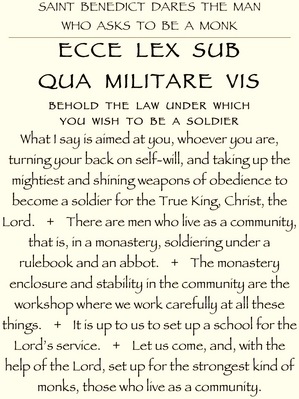Tag: Benedictine
Learning Benedictine monasticism: Chinese Priests train
WARSAW, Poland (CNS) — Chinese Catholic priests are studying at a Benedictine
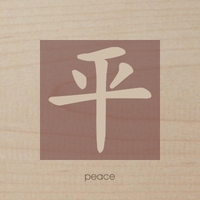 monastery in Germany in what at least one expert on the Chinese church hopes will lead to Chinese contemplative orders. “They’re sampling our spirituality and community life … and will later be returning to their homes in different Chinese provinces in May,” said Martin Wind, press officer at St. Ottilien monastery near Munich, Germany. “There’s no (current) Christian tradition of monasticism in China, so we wanted to show them what it’s like to live in a monastery. Although it isn’t our aim, we would be glad if they decided to found a monastic community when they go back.” The eight priests have been undergoing “practical training” at St. Ottilien since September 2007, Wind told Catholic News Service in a telephone interview, noting that the visit was “sensitive” and the priests would not be speaking to the media directly. “They haven’t talked openly about the possibility of being allowed to set up monastic structures in China, but they wouldn’t have come if there was no interest in the monastic life there,” said Wind.
monastery in Germany in what at least one expert on the Chinese church hopes will lead to Chinese contemplative orders. “They’re sampling our spirituality and community life … and will later be returning to their homes in different Chinese provinces in May,” said Martin Wind, press officer at St. Ottilien monastery near Munich, Germany. “There’s no (current) Christian tradition of monasticism in China, so we wanted to show them what it’s like to live in a monastery. Although it isn’t our aim, we would be glad if they decided to found a monastic community when they go back.” The eight priests have been undergoing “practical training” at St. Ottilien since September 2007, Wind told Catholic News Service in a telephone interview, noting that the visit was “sensitive” and the priests would not be speaking to the media directly. “They haven’t talked openly about the possibility of being allowed to set up monastic structures in China, but they wouldn’t have come if there was no interest in the monastic life there,” said Wind.
Pilgrimage to the Filippini Sisters, Newark Abbey & the Friars of the Renewal
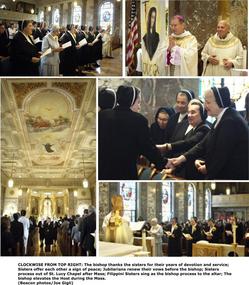 This morning, August 28th, began with the Sacrifice of the Mass offered by Father Jeremiah, a monk of Saint Mary’s Abbey, at Villa Walsh, The Institute of the Religious Teachers Filippini. The monks of Saint Mary’s Abbey have offered Mass for the sisters for many decades. We had a modest and delightful breakfast with Sister Betty Jean, the Provincial of the Filippini sisters and some other sisters. The sisters’ patience with me was grand because I had so many questions about the Congregation; I had never met a Filippini sister before and I was intrigued by their charism.
This morning, August 28th, began with the Sacrifice of the Mass offered by Father Jeremiah, a monk of Saint Mary’s Abbey, at Villa Walsh, The Institute of the Religious Teachers Filippini. The monks of Saint Mary’s Abbey have offered Mass for the sisters for many decades. We had a modest and delightful breakfast with Sister Betty Jean, the Provincial of the Filippini sisters and some other sisters. The sisters’ patience with me was grand because I had so many questions about the Congregation; I had never met a Filippini sister before and I was intrigued by their charism.
The vocation of a Filippini sister, based on what Saint Lucy Filippini and Cardinal Mark Anthony Barbarigo gave to the Church is your fundamental living of the Gospel being a contemplative in action, that is, A Filippini sister has a life of prayer with her life of ministry. Sounds like the Jesuits and other orders founded since the 16th century; and you can see these sisters are serious about their vocation when you meet them. Saint Lucy and the Cardinal founded schools of Christian Doctrine for girls in Italy, ministered to the poor and the sick, conducted retreats and guided the women preparing for marriage. What more does the Church need?
Later in the morning, Father Jeremiah and I ventured to Newark Abbey and Saint Benedict Prep
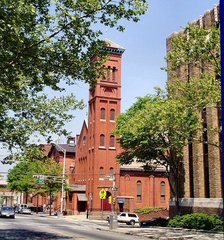 to visit with the Benedictine monks, particularly Brothers Maximilian and Patrick. We prayed Mid-day prayer in a beautiful abbey church, toured the school, Saint Mary’s Parish and the abbey. Newark Abbey is the original site of the Benedictine monks of the American-Cassinese Congregation sent by Archabbot Boniface Wimmer in 1857 to Newark. It is from this abbey that Saint Anselm’s Abbey and later college where founded in Manchester, NH, and Saint Mary’s Abbey in Morristown, NJ. Brothers Maximilian and Patrick were very gracious hosts and great fun. We lunched at The Tops Diner (East Newark) and visited Newark’s Basilica of the Sacred Heart. You would not believe the beauty of this cathedral church! Even Pope John Paul II made a visit here and former President William Clinton remarked how surprised he was to see such a magnificent in Newark, New Jersey. A brief video was produced in 2007 by the NJ Star Ledger on the Newark Abbey monks, have a look.
to visit with the Benedictine monks, particularly Brothers Maximilian and Patrick. We prayed Mid-day prayer in a beautiful abbey church, toured the school, Saint Mary’s Parish and the abbey. Newark Abbey is the original site of the Benedictine monks of the American-Cassinese Congregation sent by Archabbot Boniface Wimmer in 1857 to Newark. It is from this abbey that Saint Anselm’s Abbey and later college where founded in Manchester, NH, and Saint Mary’s Abbey in Morristown, NJ. Brothers Maximilian and Patrick were very gracious hosts and great fun. We lunched at The Tops Diner (East Newark) and visited Newark’s Basilica of the Sacred Heart. You would not believe the beauty of this cathedral church! Even Pope John Paul II made a visit here and former President William Clinton remarked how surprised he was to see such a magnificent in Newark, New Jersey. A brief video was produced in 2007 by the NJ Star Ledger on the Newark Abbey monks, have a look.
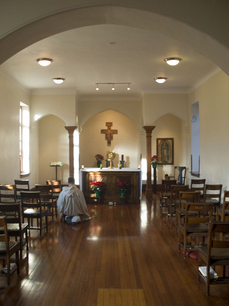 The last treat of the day was the afternoon visit to the Community of the Franciscan Friars of the Renewal based at the Friary of the Blessed Sacrament (Newark, NJ). This is the group founded by Father Benedict Groeschel and seven other Capuchin friars in 1987. The friary was the former the Monastery of Saint Dominic (nuns of the 2nd order of the Order of Preachers). It was indeed a privilege to visit the friary: it was peaceful, prayer-filled and beautiful (much work has been in the 4 years since the coming of the friars). When the nuns moved to other monasteries, their dead were exhumed and reburied in a local cemetery, including the incorrupt body of an extern sister known for holiness, Sister Mary of the Blessed Sacrament who died in 1899. Our host at the friary was Father Richard who graciously illustrated for us the life of the friars: their simple life, their prayer and their clear witness to the Gospel of Jesus Christ. What I experienced was genuine and one which I have confidence is made by God for service in the Church.
The last treat of the day was the afternoon visit to the Community of the Franciscan Friars of the Renewal based at the Friary of the Blessed Sacrament (Newark, NJ). This is the group founded by Father Benedict Groeschel and seven other Capuchin friars in 1987. The friary was the former the Monastery of Saint Dominic (nuns of the 2nd order of the Order of Preachers). It was indeed a privilege to visit the friary: it was peaceful, prayer-filled and beautiful (much work has been in the 4 years since the coming of the friars). When the nuns moved to other monasteries, their dead were exhumed and reburied in a local cemetery, including the incorrupt body of an extern sister known for holiness, Sister Mary of the Blessed Sacrament who died in 1899. Our host at the friary was Father Richard who graciously illustrated for us the life of the friars: their simple life, their prayer and their clear witness to the Gospel of Jesus Christ. What I experienced was genuine and one which I have confidence is made by God for service in the Church.
What a day! Say a prayer for the Filippini sisters, the monks of Newark and the Friars of the Renewal: they need our moral and spiritual solidarity, indeed they need we ought to be in friendship with them. Perhaps more accurately, we need their witness!
Visiting The Abbey of Saint Paul, Newton, NJ
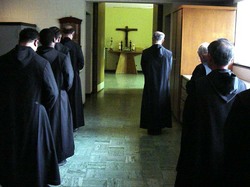 Today, Father Basil and I went for a drive to Saint Paul’s Abbey in Newton, New Jersey. A very splendid day away visiting some of his former confreres (Fr. Basil was a monk of St. Paul’s before transferring his stability to St. Mary’s Abbey, Morristown).
Today, Father Basil and I went for a drive to Saint Paul’s Abbey in Newton, New Jersey. A very splendid day away visiting some of his former confreres (Fr. Basil was a monk of St. Paul’s before transferring his stability to St. Mary’s Abbey, Morristown).
The Prior of Saint Paul’s, Father Samuel, received us most graciously; we joined the monks for Mid-Day prayer and lunch. Father Basil and I spent time visiting the abbey’s cemetery.
It was a delight to visit a venerable abbey such as Saint Paul’s because of its monastic witness and because of its missionary work. This abbey belongs to the Saint Ottilien Congregation of monks which is a missionary congregation.
Saint Mary’s Abbey, Morristown, New Jersey
The Abbey of Saint Mary was founded in Newark, New Jersey in 1857 as a conventual priory; the Holy See raised Saint Mary’s to an Abbey in 1884, electing Father James Zilliox as the first abbot. On July 23, 1956, the abbey was transferred to Morristown, New Jersey, in the Diocese of Paterson. The “Saint Mary” in the title of the monastery is to honor the “Blessed Virgin Mary of the Immaculate Conception.”
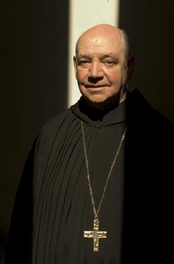 Today, the Abbey of 47 monks is led by Abbot Giles P. Hayes, OSB; he’s the tenth abbot, elected the monks in solemn vows on March 8, 2006.
Today, the Abbey of 47 monks is led by Abbot Giles P. Hayes, OSB; he’s the tenth abbot, elected the monks in solemn vows on March 8, 2006.
Monks do a wide range of things. Their first obligation is the monastic life as it is laid down by the Rule of Saint Benedict, the Constitutions of the American-Cassinese Congregation and the various customs of the house. So, the life is situated around prayer, personal and communal. The personal side of a monk’s prayer life is determined individually (hence the use of “personal”) and typically includes lectio divina, the rosary, Eucharistic adoration and spiritual reading. While it is not true that all of the monks do all of these pious acts all of the time, many are faithful to many of the practices on a daily basis. Lectio divina is clearly the most important prayer that a monk has to be faithful to or else his monastic life suffers.
Communally, the monks of the abbey gather in the abbey church 4 times a day for the Divine Office and then for the Sacrifice of the Mass. The work of the monk is not the school or any other activity. The work of the monk is the opus Dei, the Office and Mass –the source and summit of one’s relationship with God lived out in the Church. The hours are for the better part of the year as a follows (the order changes in the summer and holidays):
Lauds at 6:30 am
Sext at 11:45 am
Vespers and Mass at 5:15 pm
Vigils at 7:15 pm
Compline is prayed in private
